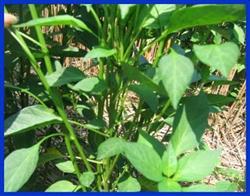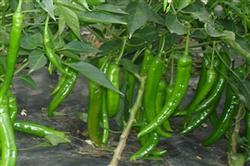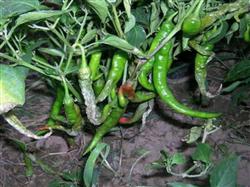High-yield cultivation techniques of Capsicum in Spring, Summer and Autumn in greenhouse

At present, the main problems in production are mainly production in early spring, less production in autumn after removal of plastic film in summer, listing of vegetables in open field after summer, relaxed management, and low yield of pepper in the later stage. In order to maximize the production role of greenhouse facilities, the author instructs the masses to carry out one-crop cultivation in spring, summer and autumn in greenhouse, through technical measures such as raising seedlings in greenhouse in winter and spring, plastic film mulching in early spring, cooling of sunshade net in summer, timely covering in autumn and so on. The yield per mu of pepper reached 4000000kg, the output value per mu reached 6000000kg, and the effect of increasing yield and income was very obvious. Now this technology is summarized in order to guide farmers to better carry out production. First, the selection of improved varieties meets the following five requirements: first, high yield, with a yield of more than 3500 kg per mu; second, strong disease resistance, mainly resistance to virus, blight and anthracnose; third, early maturity, 3-7 days earlier than ordinary varieties; fourth, high quality, mainly good product merchandise, resistance to storage and transportation, high commodity fruit rate and good market sales. Fifth, strong stress resistance, requiring cold and heat resistance, low temperature and weak light resistance. The main varieties recommended in production are: Yangjiao Jiao Nongda 22, Niujiao Jiao Xiangyan 19, Luojiao 4, Xinfeng 3, Lantern Pepper Zhongjiao 12. Second, cultivate strong seedlings 1. The seedling raising period is the most suitable period in the first and middle of January. After early seedling planting, the external temperature is too low and easy to be frozen, which increases the management cost; too late, it is easy to meet with the mature sales period of open-field pepper, and the product market price is low, which affects the income. two。 The main way of raising seedlings is the sunny border with a small arch shed in the solar greenhouse. if there is a hot line in the greenhouse, the raising date can be postponed by 7-10 days, and it is best for those without heating facilities to raise seedlings from the first ten days of January. Measures such as drying seeds before sowing, screening blighted seeds, soaking seeds in warm soup and promoting germination can be directly seeded in the seedling bed when the seeds are white. Mulch the solar greenhouse 5-6 days before sowing, make the seedling bed, raise the room temperature, and prepare for sowing. 3. When the seedlings in the seedling border reach 4 leaves and 1 heart, transplant the seedlings in the seedling bed in time to prevent the seedlings from growing too big, crowded and overgrown, and carry as much soil as possible to reduce root damage. The suitable distance between seedlings and rows should be 8 cm and 10 cm. 4. Before cultivating strong pepper seedlings, the seedling bed should be watered thoroughly, not too much water should be watered after seedling separation, and it should not be watered in overcast and snowy days. If the seedlings are dry, spraying pot water or covering wet soil can be used on sunny days. The temperature of the seedbed was kept at 15: 20 ℃ at night and 20: 25 ℃ during the day. When planting, the plant height is about 20 cm, the number of leaves is 12-14, and the stem diameter is 0.4-0.5 cm, which is the strong seedling standard of flower bud. Third, fertilization and planting 1. Before the application of sufficient base fertilizer, the greenhouse was combined with deep ploughing, applying rotten organic fertilizer 3000kg / mu, calcium superphosphate 50kg, urea 5kg, potash fertilizer 15kg / mu as base fertilizer, turning 20cm deep, leveling the ground for planting. two。 The reasonable time of close planting should be in the first and middle days of March, which can be divided into two forms: flat border plastic film mulching, wide and narrow row double plant planting and single plant planting with equal row spacing. Two plants were planted in wide and narrow rows, with a wide row spacing of 70 cm, a narrow row spacing of 50 cm covered with plastic film, a hole spacing of 25 cm and 27 cm, 2 plants per hole and 3 800 to 4000 holes per mu. When single plant was planted with equal row spacing, the row spacing of working row and plastic film covered row was 60 cm, hole spacing was 18 cm 20 cm, and 5000 × 6000 holes per mu. No matter which form is adopted, it is necessary to keep about 6000 seedlings per mu in order to achieve high yield. Fourth, field management 1. Temperature management in early spring (frost period from March to April 20) is mainly cold prevention and heat preservation. After planting, a small arch shed is built in the greenhouse to increase temperature by multi-layer mulching to prevent frost damage, mainly by covering the greenhouse tuyere late and early, keeping the greenhouse temperature at 20: 30 ℃ in the daytime and 16: 20 ℃ at night. In summer (from April 20 to the Beginning of Summer), the temperature of the greenhouse was mainly lowered, and the small arch shed was removed for greenhouse management. The Beginning of Summer opened the air vents at both ends of the greenhouse for day and night ventilation. After the middle of June, there should be skirt wind on both sides of the greenhouse, leaving a vent every 3 meters, with a sunshade net at the top. The greenhouse temperature is 25: 30 ℃ in the daytime and 20: 22 ℃ at night, keeping the greenhouse temperature no more than 32 ℃. Remove the sunshade net at the beginning of September, enter the greenhouse for autumn and postpone production, close the air vents on both sides of the greenhouse in the last ten days, and keep the greenhouse temperature at 20: 30 ℃ during the day and 15: 20 ℃ at night. The Beginning of Winter finished production around the beginning of November. two。 Fertilizer and water management should not be watered too much when planting in early spring in March, in case the soil temperature should be lowered, slow seedling water should be watered once after slow seedling for 5-7 days, and door pepper should not be watered before sitting. During the expansion period of door pepper at the end of April and the beginning of May, the fruit expansion water was irrigated once, and 20 kg of Zhengwang brand was applied with the water. After that, in the fruiting period, one irrigation and one irrigation was harvested and applied once. When the temperature in the shed is too high in summer, flood irrigation can be carried out every 7 to 10 days according to the weather conditions. With the decrease of temperature in autumn, pepper in greenhouse began to grow normally, branches and leaves flourished, flowering increased, forming a secondary yield peak period. At this time, water should be irrigated every 10 days or so, and 10 kg urea should be applied with water each time. 3. Other management measures one is the early spring fruiting period, combined with pest control with 0.2% urea solution and 1% potassium dihydrogen phosphate solution for foliar spraying fertilizer to enhance plant cold resistance. Second, when covering the sunshade net and putting skirt wind around the greenhouse in summer, we should use the film-pressing line to prevent the strong wind from taking off the greenhouse film and sunshade net. Third, timely picking, especially door pepper and pepper, greenhouse pepper mainly to harvest green fruit, 30 days after flowering can be harvested, timely harvest can promote follow-up flowering and fruiting. In autumn, we should also pay attention to remove the old leaves and yellow leaves in the lower part of the plant to enhance the light transmittance in the field. 5. Integrated pest control 1. Disease control is mainly divided into physiological diseases and pathological diseases. Physiological disease of ①. Prevention and control of "three falling" diseases (falling flowers, fruits and leaves): the first is to strengthen temperature management in the greenhouse to prevent the occurrence of too low and high temperature; the second is to maintain suitable soil moisture to prevent excessive drought or waterlogging; and third is to strengthen the prevention and control of diseases and insect pests. reduce the resulting drop of flowers, fruit and leaves. Stiff fruit: after the onset of the disease, the fruit is in the shape of small persimmon, strawberry-shaped in the later stage, thick and hard skin, bright color, long stalk, seedless or few seeds in the fruit, no spicy taste, and the fruit does not expand to become a stiff fruit. Prevention and control measures: one is to provide sufficient fertilizer and water during flower bud differentiation to ensure adequate nutrition and sound development of flower buds; the second is to control the greenhouse temperature, which is 23: 30 ℃ during the day and 15: 18 ℃ at night; and the third is to irrigate the roots with zinc sulfate 1000 times solution during seedling refining, and 0.3% boron fertilizer solution is sprayed at flowering stage to promote plant growth. Pathologic disease of ②. The main causes of quenching disease at seedling stage are low temperature and high humidity in seedling bed, and cultivation measures mainly include pulling out diseased plants, sprinkling plant ash and dry soil on seedling bed, increasing temperature and light of seedling bed with incandescent lamp, spraying with chlorothalonil, copper hydroxide wettable powder and so on. The disease in field production is mainly blight, which is a destructive disease, which is mainly controlled by insecticides. 40% aluminum triethyl phosphonate and 72.2% aldicarb can be sprayed once every 5-6 days for a total of 3 times. Virus diseases are mainly prevented and treated by virus A, plant disease spirit and so on. two。 The main pests are aphids, whitefly, tea yellow mite, tobacco green worm, cotton bollworm and so on. Pyrethroids pesticides, Bacillus thuringiensis, avermectin and other biological pesticides can be used for control.
- Prev

Guiding Opinions on Scientific Fertilization of Pepper in Spring
The essence of selecting fine varieties for cultivation in winter and spring is early maturity cultivation, attention must be paid to early maturity of varieties, giving consideration to high yield and disease resistance. Suitable varieties are red Yingda, Andalai, Holy Ark, in addition to Bulgarian pepper, Su pepper No. 5 and so on. Soil preparation and fertilization 10000 kg of high-quality manure or compost per mu, furrow urea...
- Next

Field Management techniques of Spring Pepper
The main type of the disease is leaf rot in the open field and root rot in the protected area. Pepper blight mostly invaded from the root neck in the protected area, and the disease part was dark brown. Sunken or atrophied, the disease spot can surround the stem and cause root death and plant withering. In the shed, the bacteria are mainly spread by irrigation water, and the disease centers are mostly formed in low-lying water and soil in the shed.
Related
- Where is it suitable to grow horseradish in China? it is expected to see the middle altitude horseradish in Alishan.
- How to prevent tomato virus disease reasonably? (Control methods included)
- Many people like to plant towel gourd on the balcony. What are the main points of this method and management?
- What crops can chili peppers be mixed with?
- Fertilization techniques and matters needing attention in Tomato
- What are the grafting techniques for peach seedlings in spring?
- Harm and control methods of root swelling disease of Chinese cabbage
- What are the pests of sweet potatoes? How to prevent and cure it?
- Symptoms, causes and Control methods of navel Rot in Tomato
- The cause of "Cucumber rotten bibcock" in Farmers' planting Cucumber and its Control Plan

